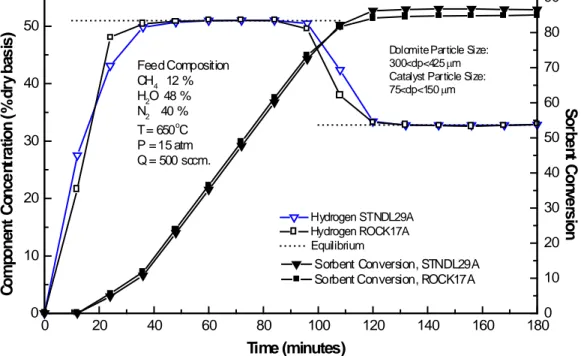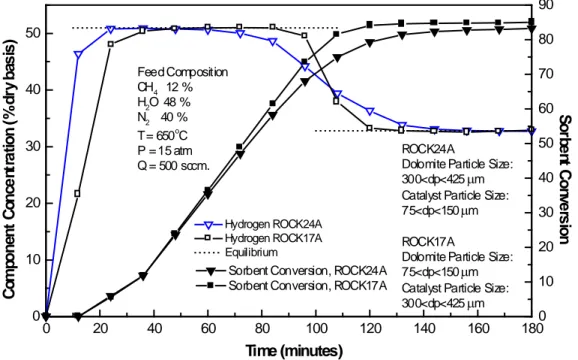SER PROCESS VARIABLE EVALUATION FOR THE PRODUCTION OF HYDROGEN USING CALCINED DOLOMITE
Texto completo
(2) 1.-Introduction Steam methane reforming (SMR) is the most conventional and used route to industrially produce hydrogen nowadays. This process is composed by the following chemical reactions: CH4 + H2O ↔ CO + 3H2. ΔH298 = 206.2 kJ/mol. (1). CH4 + 2H2O ↔ CO2 + 4H2. ΔH298 = 164.9 kJ/mol. (2). CO + H2O ↔ CO2 +H2. ΔH298 = −41.1 kJ/mol. (3). Reforming reactions (1) and (2) are highly endothermic and thermodynamically favored at high temperatures and low pressures. Otherwise, the water gas shift (WGS) reaction (3) is favored at low temperature with pressure having a negligible effect on this. SMR Industrial operation is commonly performed at 750-900°C; this is because of the strong endothermic nature of the reforming reactions [1]. Even though high temperature is critical in order to ensure large methane conversions this also adversely promotes the reverse WGS reaction thus producing a gas product with 8–10% CO (dry basis) content. Therefore, it is convenient to feed this gas to a second stage WGS reactor operating as low as 300–400°C to produce more H2 and reduce the amount of unreacted CO. Finally, to obtain the hydrogen product the effluent of the second WGS reactor is conventionally fed to a pressure swing adsorption unit (PSA) where the H2 purity can reach up to 99% [2]. During the industrial operation CO2 is released as a greenhouse gas with potential to significantly contribute to global warming. In hydrogen production the in-situ capture of CO2 within the SMR reaction system has two main advantages; first by providing the opportunity to sequester a greenhouse gas (CO2) instead of its release to the atmosphere and second to improve the overall process by enhancing the methane conversion and hydrogen yield at significantly lower operational temperatures, overcoming system equilibrium limitations..
(3) Several studies related to enhancing the SMR and WGS reactions through in-situ separation of CO2, employing chemical absorbents are available in the literature. The use of dolomite as CO2 absorbent, containing a Ni-based catalyst in a fluidized bed reactor was first proposed by Brun-Tsekhovoi et al. [3] that reported an enhancement of CH4 conversion towards higher H2 production. Han and Harrison and Escobedo et. al., [4, 5] studied the H2 production via the WGS reaction using dolomite as a CO2 absorbent in the temperature range of 500–600°C. They reported carbon oxides concentrations as low as 50 ppm in the product gas. This reaction concept was called sorption enhanced reaction (SER) by Sicar and co-workers (Carvill et al., [6]; Hufton et al., [1]; Waldron et al., [7]). However they used CO2 adsorbents such as hydrotyalcites, which are limited by their relatively low CO2 capture capacity and operational temperatures (i. e. 400°C). The use of CaO as a CO2 absorbent in a SMR fixed bed reactor was reported by Balasubramanian et al. [8], showing that hydrogen can be produced with a purity of more than 95% in a single step SMR process at 650°C and above. In this case in addition to the SMR and WGS reactions (equations (1)–(3)); the non catalytic highly exothermic carbonation reaction (equation (4)) was included in SER system: CaO + CO2 ↔ CaCO3. ΔH298 = −178 kJ/mol. (4). The advantages of combining steam reforming with in situ CO2 capture can be seen in thermodynamics. Figure 1 presents the equilibrium hydrogen concentration (dry-basis) as a function of reaction temperature at 15 atm and with an S/C (steam to carbon) ratio equal to 4 performed using the HSC equilibrium software [9].. It is clear from Figure 4 that the use of CaO enables both lower reaction temperatures, which may reduce catalyst coking and sintering, and the consequent use of less expensive reactor wall materials. Furthermore, heat released by the exothermic carbonation reaction supplies most of the heat required by the endothermic reforming reactions..
(4) absorbent. absorbent. Figure 1. Comparison between SMR and SER equilibrium H2 content vs temperature For a calcium oxide absorbent process, the typical operating temperatures are about 500– 650°C (not considering the adverse formation of Ca(OH)2). However, energy is required to regenerate the absorbent back to its oxide form by the energy intensive calcination reaction (reverse of equation (4)). Although many works have reported that the energy required for the regeneration process is less than 20–25% the supplementary energy required for traditional SMR.. In another study, Lopez-Ortiz and Harrison [10] reported the use of calcined dolomite (instead of CaO) and a commercial Ni-based reforming catalyst in a fixed bed reactor (650°C, 15 atm) to examine the effect of regeneration conditions of the spent dolomite as a function of temperature and regeneration gas composition in a multicycle scheme. The absorbent showed only moderate activity loss under most of the regeneration conditions employed. In recent experiments performed by Ishida et al., [11] SMR was carried out using a fluidized bed reactor and dolomite as the CO2 absorbent. Tests were carried out at 5 bars and 580°C. In all the experiments the total flow through the catalyst/absorbent bed was 300 ml (STP)/min, which was found to be well above the minimum fluidization condition in the bubbling regime giving minimal attrition..
(5) Johnsen et al. [12] conducted a similar experimental study in a fluidized bed and demonstrated that hydrogen concentration remained at 98–99 vol % after four cycles. They used two bubbling beds because it was found that this fluidization scheme resulted in better performance towards hydrogen production than the fast fluidization regime (riser reactor). These results were confirmed by Jakobsen and Halmøy [13], which performed a reactor modeling of the of sorption enhanced steam methane reforming comparing the fast fluidization with the bobbling regimes using dolomite as absorbent. The agreement between the model and the experimental data was satisfactory. They found that the addition of dolomite has a rather small effect on the enhancement of the SMR process, with a hydrogen yield of 79.3% for a riser length of 15 m. The residence time of the particles in the riser reactor was too short for dolomite in order to influence the reaction equilibrium significantly. Simulations of the reformer as a bubbling bed reactor showed that bubbling fluidization was much more suitable flow regime than the fast fluidization. Carrying out the reforming in bubbling bed resulted in hydrogen yields up to 99.9% depending on the gas velocity and solids residence time. It was found that the bubbling bed reactor is the best configuration of the two studied configurations when using dolomite as the absorbent. These results were attributed to the fact that longer residence times were needed to obtain higher methane conversions and these were related to the dolomite slow absorption kinetics especially towards the end of complete carbonation.. Recently, Ryu et. al., [14] studied reactor configurations for the sorption-enhanced steam methane reforming and agreed that the best configuration was the bubbling regime. They pointed out that this mode is usually applied when two reactions are slow and longer contact time between gas and solid is favorable (as is the case for dolomite). However, this mode is difficult to operate because maintaining the pressure balance for three fluidized beds and loopseals is complex, and a back flow of solid is the main problem. Indeed, this mode requires much solid inventory in loopseals and many gas injection ports of at least five. In this mode it is also difficult to maintain the pressure balance for two fluidized beds and loopseals (or other non-mechanical valves) and they concluded that the complexity and huge system volume are the main disadvantages for this system to be successfully applied. Also, they suggested that fixed moving beds configuration, even tough are difficult to.
(6) operate, are becoming a feasible option for SER applications as modeling results reported by Reijers et al., also suggested [15]. Hence, there is renewed interest within the scientific community to study sorption enhanced reforming using dolomite within a fixed-bed reactor configuration. Therefore, the present research is aimed to establish the fixed-bed reactor performance of the steam methane reforming (SMR) using commercial dolomite as inexpensive solid CO2 absorbent as a function of temperature, feed gas composition, dolomite type, and dolomite and catalyst particle sizes leading to the sorption enhanced reforming (SER) process for the production of hydrogen.. 2. - Experimental A scheme of the bench scale fixed-bed reactor is presented in Figure 2. In the hydrogen production step, methane and nitrogen (balance) were acquired from high-purity gas cylinders; each flow rate was feed through mass flow controllers (MFC).. Figure 2. Bench scale fixed-bed reactor system. Water was introduced to the system as a liquid using a high-pressure syringe pump. Feed lines were heat-traced, and N2 balance was used in most runs to ensure complete vaporization of water. The combined feed gases enter the reactor and contacted a mixture of reforming catalyst and CO2 absorbent (calcined dolomite). Product gas from the reactor.
(7) was passed through a condenser to eliminate excess water and pressure reduced by a back pressure regulator. The product gas was analyzed using a Shimadzu GC14A gas chromatograph equipped with FID and TCD detectors connected in series. Two different sources of commercial dolomite were used for comparison purposes, Rockwell dolomite from Rockwell Lime Company and Stonelite dolomite from Redland Ohio Inc. Approximately 40 g of mixed pretreated dolomite (Rockell or Stonelite) and a commercial NiO/Al2O3 reforming catalyst (United Catalyst Inc., C11-9-02 ≈ 18%W NiO) in a mass ratio of 2.2-2.7 was supported inside the reactor insert by a layer of quartz wool on top of a porous stainless steel frit disk. Both solids were crushed into powders with two particle size ranges, 75≤dp≤150 μm and 300≤dp≤425 μm, were chosen for testing. Test conditions used in the reaction were temperatures of 550 and 650°C, 15 atm and a feed gas composition was varied from 6 to 20% CH4/balance N2 and steam, with a feed H2O/CH4 ratio = 4 at 200 (STP) cm3/min total flowrate. Pretreatment of the commercial dolomite to remove sulfur was necessary to avoid sulfur release during reaction with consequent catalyst poisoning. Further details of the sulfur removal pretreatment can be found in Lopez-Ortiz and Harrison [10]. Two sources of dolomite were used; Rockwell and Stonelite. Particle sizes of dolomite and catalyst were 75>dp>150 µm and 300>dp>425 µm, respectively and were inversely varied.. 3. - Results and Discussion 3.1 Temperature Effect Reaction tests were performed aimed to compare results using pretreated dolomite with respect to the high purity CaO tests reported previously in the literature [8]. Based on the thermodynamic analysis presented in Figure 1, experimental tests were made at 550 and 650°C. Runs ROCK 19A and ROCK 19B were carried out using a feed concentration of 64% H2O, 16% CH4 and 20% N2, and a flowrate of 200 (STP)/cm3min. The reactor was loaded with 29.9g of pretreated Rockwell dolomite with particle size of 300<dp<425 μm and 11 g of catalyst having a particle size of 75<dp<150. Figure 3 shows hydrogen concentration (dry basis) and absorbent conversion versus time. The three horizontal lines in the first steady state hydrogen region represent, from top to bottom, the equilibrium concentration at 650°C (where no Ca(OH)2 is formed), 550°C with only CaCO3 formation.
(8) permitted, and 550°C with both Ca(OH)2 and CaCO3 formation allowed. Prebreakthrough hydrogen concentration at 650°C was 71.6% H2 (dry basis) only 0.2% below equilibrium, compared to 66.6% H2 (dry basis) at 550°C. The 550°C experimental value was between the equilibrium of CaCO3 (71.3%) and CaCO3 plus Ca(OH)2 (61.8%). Therefore, the 66.6% H2 (dry basis) at 550°C suggests the possibility of partial formation of Ca(OH)2 together with CaCO3. This behavior could also be due to slower kinetics at 550°C. 80. 100 o. 90. o. CaCO3, 550 C. 60. 80 o. Ca(OH)2, 550 C. 70. P = 15 atm Dolomite Particle Size: 300<dp<425 µm Catalyst Particle Size: 75<dp<150 µm Flowrate: 200 sccm. 40. o. CaCO3, 650 C H2. 60 50. o. CaCO3, 550 C 40. 0. Hydrogen, T = 550oC Hydrogen, T = 650oC Sorbent Conversion, T = 550oC. Feed Composition CH4 16 % H2O 64 % N2 20 %. 20. Sorbent Conversion, T = 650oC. 30. Sorbent Conversion. Component Concentration (% dry basis). CaCO3, 650 C. 20 10 0. 0. 50. 100. 150. 200. 250. 300. 350. 400. 450. Time (minutes). Figure 3. Temperature effect in a SER tests using calcined dolomite Prebreakthrough and postbreakthrough regions were not clearly defined at 550°C. The maximum of 66.6% H2 (dry basis) was between the equilibrium lines corresponding to CaCO3 only and CaCO3 plus Ca(OH)2. The breakthrough time was unusually prolonged with the H2 concentration slowly reduced over a period of time from 120 minutes to about 455 minutes, producing a breakthrough time of about 335 minutes, compared to only 77 minutes at 650°C. This long breakthrough time reflects the complexity of the overall reaction rate in which the reforming, water-gas shift, carbonation and calcium hydroxide reactions occur simultaneously. Absorbent conversion at the beginning of breakthrough was only 28.2% at 550oC compared to 62.8% at 650oC. Absorbent conversions at the end of the breakthrough were similar with.
(9) 94.6% at 650oC compared to 96.1% at 550oC. The postbreakthrough minimum H2 concentration at 550oC was 33.9%, only 0.1% below the postbreakthrough equilibrium value of 34.0%. 650oC produced a postbreakthrough H2 concentration of 46.1% H2 (dry basis), only 0.4% below the equilibrium value of 46.5% H2 (dry basis). It was not possible to analyze for the presence of Ca(OH)2 in the 550oC solid product due to the fact that Ca(OH)2 would decompose when a N2 purge was introduced. These results are in agreement with recent experiments from Hildenbrand et al., [16] who studied the sorbent enhanced steam reforming using dolomite in a fluidized bed reactor at temperatures below 600°C and 5 atm. They found that after XRD examination of the catalyst/absorbent powder at different times CaO of the calcined dolomite reacted with water vapor to form Ca(OH)2 through: H2O + CaO ↔ Ca(OH)2. ΔH298 = −109 kJ/mol. (5). and that initially CaO reacts partly with water forming hydroxide and partly with carbon dioxide forming carbonate. They suggested that at initial reaction times the formation of Ca(OH)2 would lead to a lower H2O/CH4 (S/C) ratio within the system and that after a certain time the formation of Ca(OH)2 would reached equilibrium leading to a higher H2O/CH4 ratio and thus higher conversion of methane. They estimated the reduction of the S/C ratio from 2 to a value of 1.5. However, this is only partially true, because the influence of a lower reaction temperature over the formation of Ca(OH)2 is a determinant factor as predicted by thermodynamics as shown in Figure 1. This temperature effect is presumably more important than the reduction of the S/C ratio because, even if a greater S/C ratio is employed, as in the case of the present study (S/C = 4) where a reduction in methane conversion is observed This reduction is not due to a S/C ratio reduction since there is excess steam in the system, but to a lower temperature effect leading to a reduced H2 concentration at 550°C as shown in Figure 3. On the basis of these results, all subsequent reaction tests were performed at 650oC and 15 atm to avoid the formation of Ca(OH)2..
(10) 3.2 Feed Gas Composition Figure 4 presents the effect of feed gas composition on the prebreakthrough and postbreakthrough H2 content using both Rockwell and Stonelite dolomite. In this Figure H2 product concentration (dry basis) is plotted against CH4 feed concentration. The solid and dashed lines represent the H2 content at equilibrium for the prebreakthrough and postbreakthrough periods, respectively.. H2 Concentration, % (dry basis). 100. Prebreakthrough Equilibrium Postbreakthrough Equilibrium Stonelite Dolomite Rockwell Dolomite. 80. S/C Ratio = 4 o. T = 650 C P = 15 atm. 60. 40. 20 6. 8. 10. 12. 14. 16. 18. 20. CH4 Feed Concentration, % Figure 4. SER tests using different CH4 feed gas concentrations Discrete points represent experimental results for the series of tests performed at 650°C and 15 atm, at a constant steam-to-carbon (S/C) ratio of 4. The superiority of the SMR process using a solid acceptor (dolomite) is evident. The prebreakthrough H2 concentration ranged from 24% when the feed contained 6% CH4 to 96% when the feed contained 20% CH4. In contrast, during postbreakthrough, which corresponds to absence of dolomite, the hydrogen concentration ranged from about 16% to 65% (dry basis). The addition of the CO2 absorbent increased the H2 concentration by about 50%..
(11) 3.3 Dolomite Type Figure 5 presents the results of two runs (STNDL29A and ROCK17A) using Stonelite and Rockwell dolomites, respectively, and performed under feed concentrations of 48% H2O, 12% CH4, and 40% N2, 500 (STP)cm3/min, 650°C, and 15 atm. The same dolomite and catalyst particle size ranges of 75<dp<150 and 300<dp<425 μm, respectively, were used.. 50. 80 Dolomite Particle Size: 300<dp<425 µm Catalyst Particle Size: 75<dp<150 µm. Feed Composition CH4 12 % H2O 48 % N2 40 % o T = 650 C P = 15 atm Q = 500 sccm.. 40. 30. 60 50 40. 20. 30. Hydrogen STNDL29A Hydrogen ROCK17A Equilibrium. 10. 0. 20. Sorbent Conversion, STNDL29A Sorbent Conversion, ROCK17A. 0. 20. 40. 60. 70. 80. 100. 120. 140. 160. Sorbent Conversion. Component Concentration (%dry basis). 90. 10 0 180. Time (minutes). Figure 5. SER tests dolomite type effect. Prebreakthrough and postbreakthrough hydrogen concentrations were almost equal to the equilibrium values of 51.0% and 32.8% (dry basis), respectively. Experimental prebreakthrough and postbreakthrough H2 (dry basis) concentrations of 51.0% and 51.0%, and 32.6% and 32.7%, were measured for Rockwell and Stonelite dolomites, respectively. Absorbent conversion at the start of breakthrough was almost the same for both runs 73.9% and 74.2% for the Rockwell and Stonelite dolomites, respectively. At the end of breakthrough a sorbent conversion of 83.3% was achieved with Rockwell dolomite, compared to 85.6% using Stonelite dolomite. Breakthrough time was only 5 minutes greater using Stonelite dolomite than with Rockwell dolomite, 20 minutes compared to 15..
(12) Therefore, from these results it can be concluded that the reaction behavior of Stonelite and Rockwell dolomites is effectively equal when exposed to the same reaction conditions.. 3.4 Dolomite and Catalyst Particle Sizes The effects of dolomite and catalyst particle sizes on H2 concentration and acceptor conversion are presented in Figure 6. Both tests used Rockwell dolomite with a feed concentration of 48% H2O, 12% CH4 and 40% N2, 500 (STP) cm3/min, 650°C and 15 atm. ROCK24A test used dolomite and catalyst particle sizes in the range of 300<dp<425 μm and 75<dp<150 μm, respectively, while run ROCK17A used the opposite, with dolomite and catalyst particle sizes in the range of 75<dp<150 μm 300<dp<425 μm, respectively. Run ROCK24A used 23.2g of pretreated Rockwell dolomite and 10.6g of catalyst, while run ROCK17A used 22.2g of pretreated Rockwell dolomite and 10.4g of catalyst.. 50. 80 Feed Composition CH4 12 % H2O 48 % N2 40 % o T = 650 C P = 15 atm Q = 500 sccm.. 40. 30. 70 60 ROCK24A Dolomite Particle Size: 300<dp<425 µm Catalyst Particle Size: 75<dp<150 µm. 20 Hydrogen ROCK24A Hydrogen ROCK17A Equilibrium. 10. 0. Sorbent Conversion, ROCK24A Sorbent Conversion, ROCK17A. 0. 20. 40. 60. 80. 100. 120. ROCK17A Dolomite Particle Size: 75<dp<150 µm Catalyst Particle Size: 300<dp<425 µm. 140. 160. 50 40 30 20. Sorbent Conversion. Component Concentration (%dry basis). 90. 10 0 180. Time (minutes). Figure 6. SER tests dolomite and catalyst particle size effect. Prebreakthrough and postbreakthrough hydrogen concentrations were effectively equal in both runs and agreed with the equilibrium values of 51.0% and 32.8% (dry basis), respectively. Absorbent conversion at the start of breakthrough was lower using the larger.
(13) dolomite particle size; ROCK17A had an absorbent conversion of 73.8% compared to 55.6% in run ROCK24A. The absorbent conversions were almost equal at the end of breakthrough, with 83.3% conversion for ROCK24A and 80.6% for ROCK17A. Breakthrough time was 31 minutes longer using large dolomite and small catalyst particles with values of 46 and 15 minutes for runs ROCK24A and ROCK17A, respectively. These results suggest that the resistance associated with diffusion of CO2 into the interior of the large dolomite particles may be significant. Kinetic effects observed in the tests suggest that small dolomite and large catalyst particles favor the decrease of CO2 diffusion effects.. 4. - Conclusions The experimental results confirmed that inexpensive pretreated dolomite, as well as reagent grade CaCO3 used in previous studies by Balasubramanian et al. [8], present the same behavior towards the hydrogen production through the SER reaction system. At reaction conditions of the present study, (15 atm) temperatures of 550°C and lower, produce Ca(OH)2 along with CaCO3, as predicted by thermodynamics, which leads to the reduction of the H2 production. Greater temperatures than 600°C and a S/C = 4 prevents the formation of Ca(OH)2. The reaction behavior of Stonelite and Rockwell dolomites was effectively equal when exposed to the same reaction conditions. > 95% H2 (dry basis) can be produced in a single reaction step using inexpensive dolomite, and combined reaction equilibrium can be closely approached over the range of reaction conditions of interest in this study (6% to 20% CH4 feed gas composition). The addition of the CO2 absorbent increased the H2 concentration by about 50%. Dolomite and catalyst particle size variation results suggest that the resistance associated with diffusion of CO2 into the interior of the large dolomite particles is presumably significant with small dolomite and large catalyst particles favoring the decrease of CO2 diffusion effects. A key factor for the feasibility of this reaction system is of great concern and deals with the durability of the solid acceptor and catalyst. Catalyst and dolomite must retain activity through many reaction-regeneration cycles (multicycle operation) for the process to be economically attractive. Even though multicycle tests addressed in the past [10] concerning this durability issue were very promising, more data is necessary to be generated in order to evaluate this fixed bed SER reaction system in a moving bed operation scheme..
(14) 5.- Acknowledgements The authors are grateful to the US Department of Energy for financial support under Grant DE-FG02-97ER12208 and Doctoral Research Grant from Fulbright-Garcia Robles CONACYT.. 6.- References [1] J. R. Hufton, S. Mayorga, S. Sircar, A.I.Ch.E. Journal 45, 248 (1999). [2] D. K. Lee, I. H. Baek, W. L. Yoon, Chem Eng Sci., e 59, 931(2004). [3] A. R. Brun-Tsekhovoi, A.N. Zadorin, Y.R. Katsobashvili, S.S. Kourdyumov, The process of catalytic steam-reforming of hydrocarbons in the presence of carbon dioxide acceptor. In: Proceedings of the World Hydrogen Energy Conference, Vol. 2, Pergamon Press, New York, 885 (1986). [4] C. Han, D. P. Harrison, Chem Eng Sci., 49, 5875 (1994). [5] M. A. Escobedo Bretado, M. D. Delgado Vigil, J. Salinas Gutiérrez, A. López Ortiz, V. Collins-Martínez, J New Mater Electrochem Syst 12, 023-028 (2009). [6] B. T. Carvill, J. R. Hufton, M. Anand, S. Sircar, A.I.Ch.E. Journal 42, 10, 2765 (1996). [7] W. E. Waldron, J. R. Hufton, S. Sircar, A.I.Ch.E. Journal 47, 6, 1477 (2001). [8] B. Balasubramanian, A. Lopez-Ortiz, S. Kaytakouglu, D. P. Harrison, Chem Eng Sci., 54, 3543 (1999). [9] A. Roine, HSC Chemistry 4.1 for Windows, User’s Guide, Outokompu, Research Oy, Finland (1999). [10] A. Lopez-Ortiz, D. P. Harrison, Ind Eng Chem Res., 40, 5102 (2001). [11] M. Ishida, M. Yamamoto, T. Ohba, Energy Convers Manage, 43, 1469 (2002). [12] K. Johnsen, H. J. Ryu, J. R. Grace, C. J. Lim, Chem Eng Sci., 61, 1195 (2006). [13] J. P. Jakobsen, E. Halmøy, Energy Procedia 1, 725 (2009). [14] H. Ryu, Y. Park, S. Jo, M. Park, Korean J. Chem. Eng. 25, 5, 1178 (2008). [15] H. T. Reijers, J. Boon, G. D. Elzinga, P. D. Cobden, W. G. Haije, R. W. Van den Brink, Ind Eng Chem Res., 48, 15, 6975 (2009). [16] N. Hildenbrand, J. Readman, I. M. Dahl, R. Blom, Appl Catal: A., 303, 131 (2006)..
(15)
Figure
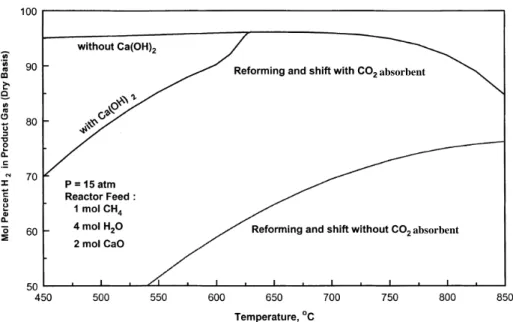
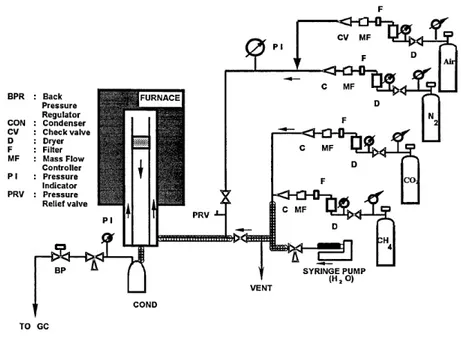
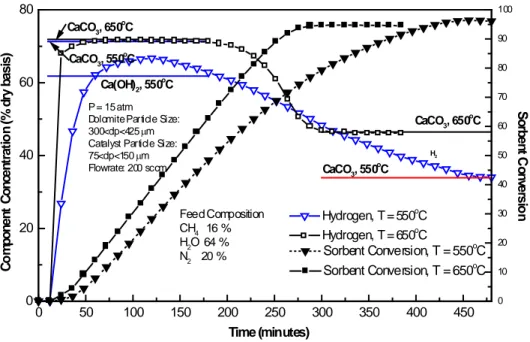
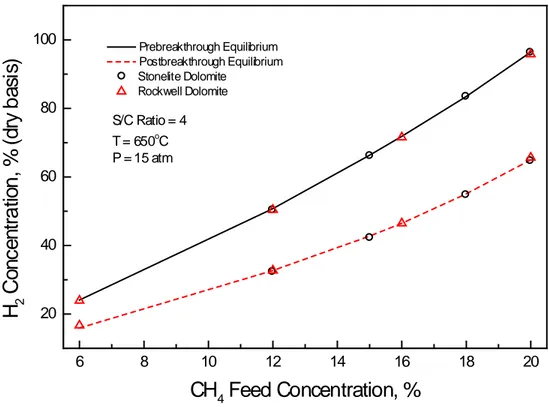
Documento similar
Parameters of linear regression of turbulent energy fluxes (i.e. the sum of latent and sensible heat flux against available energy).. Scatter diagrams and regression lines
Penelitian ini bertujuan untuk mendapatkan asal daerah bahan baku yang terbaik untuk pembuatan sirup gula kelapa dan untuk mendapatkan konsentrasi arang aktif yang
In the preparation of this report, the Venice Commission has relied on the comments of its rapporteurs; its recently adopted Report on Respect for Democracy, Human Rights and the Rule
Astrometric and photometric star cata- logues derived from the ESA HIPPARCOS Space Astrometry Mission.
The objective of this paper is to present the development process followed to obtain a control system architecture for teleoperated robots, using the Unified Modeling Lan- guage–
The objective of this paper is to present the development process followed to obtain a control system architecture for teleoperated robots, using the Unified Modeling Lan- guage-
So, the idea of this performance evaluation process is not related to present how the Monitoring platform is capable of monitoring a given 5G service and show the results obtained
Government policy varies between nations and this guidance sets out the need for balanced decision-making about ways of working, and the ongoing safety considerations
